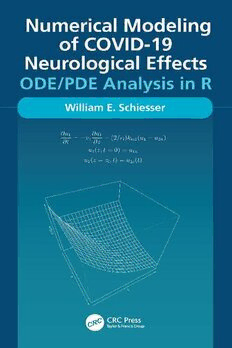Table Of ContentNumerical Modeling of COVID-19
Neurological Effects
Numerical Modeling of COVID-19
Neurological Effects
ODE/PDE Analysis in R
WilliamE.Schiesser
Firsteditionpublished2022
byCRCPress
6000BrokenSoundParkwayNW,Suite300,BocaRaton,FL33487-2742
andbyCRCPress
2ParkSquare,MiltonPark,Abingdon,Oxon,OX144RN
©2022WilliamE.Schiesser
CRCPressisanimprintofTaylor&FrancisGroup,LLC
Reasonableeffortshavebeenmadetopublishreliabledataandinformation,buttheauthorandpublisher
cannotassumeresponsibilityforthevalidityofallmaterialsortheconsequencesoftheiruse.Theauthors
andpublishershaveattemptedtotracethecopyrightholdersofallmaterialreproducedinthispublication
andapologizetocopyrightholdersifpermissiontopublishinthisformhasnotbeenobtained.Ifany
copyrightmaterialhasnotbeenacknowledgedpleasewriteandletusknowsowemayrectifyinany
futurereprint.
ExceptaspermittedunderU.S.CopyrightLaw,nopartofthisbookmaybereprinted,reproduced,trans-
mitted,orutilizedinanyformbyanyelectronic,mechanical,orothermeans,nowknownorhereafter
invented,includingphotocopying,microfilming,andrecording,orinanyinformationstorageorretrieval
system,withoutwrittenpermissionfromthepublishers.
Forpermissiontophotocopyorusematerialelectronicallyfromthiswork,accesswww.copyright.com
orcontacttheCopyrightClearanceCenter,Inc.(CCC),222RosewoodDrive,Danvers,MA01923,978-
750-8400.ForworksthatarenotavailableonCCCpleasecontactmpkbookspermissions@tandf.co.uk
Trademarknotice:Productorcorporatenamesmaybetrademarksorregisteredtrademarksandareused
onlyforidentificationandexplanationwithoutintenttoinfringe.
ISBN:978-1-032-15211-0(hbk)
ISBN:978-1-032-15213-4(pbk)
ISBN:978-1-003-24305-2(ebk)
DOI:10.1201/9781003243052
Publisher’snote:Thisbookhasbeenpreparedfromcamera-readycopyprovidedbytheauthors.
AccesstheSupportMaterial:http://www.lehigh.edu/∼wes1/cne download
TypesetinTimesNewRoman
bycodeMantra
Contents
Preface.....................................................................................................................vii
Chapter1 SourceofNeurologicalEffectsOnePDEModel............................1
1.1 Introduction.............................................................................1
1.1.1 OnePDEmodelformulation.....................................1
1.1.2 Summaryandconclusions.........................................2
References........................................................................................3
Chapter2 ImplementationoftheOnePDEModel..........................................5
2.1 Introduction.............................................................................5
2.1.1 RroutinesfortheonePDEmodel.............................5
2.1.2 Summaryandconclusions.......................................15
References......................................................................................16
Chapter3 TwoPDEModel............................................................................17
3.1 Introduction...........................................................................17
3.1.1 TwoPDEmodelformulation...................................17
3.1.2 Summaryandconclusions.......................................18
Reference.......................................................................................19
Chapter4 ImplementationoftheTwoPDEModel........................................21
4.1 Introduction...........................................................................21
4.1.1 RroutinesforthetwoPDEmodel...........................21
4.1.2 Summaryandconclusions.......................................38
References......................................................................................38
Chapter5 ThreePDEModel..........................................................................39
5.1 Introduction...........................................................................39
5.1.1 ThreePDEmodelformulation.................................39
5.1.2 ThreePDEmodelimplementation...........................39
5.1.3 Summaryandconclusions.......................................53
Reference.......................................................................................53
Chapter6 CaseStudies...................................................................................55
6.1 Introduction...........................................................................55
6.1.1 TimevariationofthebrainO concentration..........55
2
6.1.2 LHSPDEtimederivatives.......................................68
v
vi Contents
6.1.3 AnalysisofPDERHSterms....................................90
6.1.4 Summaryandconclusions.......................................98
Reference.......................................................................................98
AppendixA:IntroductiontoPDEAnalysis........................................................99
Index......................................................................................................................183
Preface
Covid-19 is primarily a respiratory disease which results in impaired oxygenation
ofblood.TheO -deficientbloodthenmovesthroughthebody,andforthestudyin
2
thisbook,thefocusisonthebloodflowingtothebrain.Thedynamicsofbloodflow
along the brain capillaries and tissue is modeled as systems of ordinary and partial
differentialequations(ODE/PDEs).
Asfurtherbackground(from[3]):
WhilefewerpeoplewhogetCOVIDaredying,notallofthemarerecovering.We
don’tknowhowmanypeoplewillremainhobbled,long-term.Butitisplausiblethat
tensofthousandsintheUnitedStatesmayneverbethesameagain.
Additionalbackgroundisprovidedin[1,2,4,5].
TheODE/PDEmethodologyispresentedthroughaseriesofexamples,
1. AbasiconePDEmodelforO concentrationinthebraincapillaryblood.
2
2. AtwoPDEmodelforO concentrationinthebraincapillarybloodandin
2
thebraintissue,withO transportacrossthebloodbrainbarrier(BBB).
2
3. ThetwomodelextendedtothreePDEstoincludethebrainfunctionalneu-
roncelldensity.
Cognitive impairment could result from reduced neuron cell density in time and
space(inthebrain)thatfollowsfromloweredO concentration(hypoxia).
2
Thecomputer-basedimplementationoftheexamplemodelsispresentedthrough
routinescoded(programmed)inR,aquality,open-sourcescientificcomputingsys-
tem that is readily available from the Internet. Formal mathematics is minimized,
e.g.,notheoremsandproofs.Rather,thepresentationisgiventhroughdetailedexam-
ples that the reader/researcher/analyst can execute on modest computers. The PDE
analysis is based on the method of lines (MOL), an established general algorithm
forPDEs,implementedwithfinitedifferences.AppendixAisabasicintroductionto
PDEmodelingandcomputer-basedanalysisthereadercanconsultwhenstartingon
Chapters1–6.
Theroutinesareavailablefromadownloadlinksothattheexamplemodelscanbe
executedwithouthavingtofirststudynumericalmethodsandcomputercoding.The
routinescanthenbeappliedtovariationsandextensionsoftheblood/brainhypoxia
models, such as changes in the ODE/PDE parameters (constants) and form of the
modelequations.
The author would welcome comments/suggestions concerning this approach to
theanalysisofbrainhypoxiaresultingfromCovid-19.
W.E.Schiesser
Bethlehem,PA,USA
vii
viii Preface
REFERENCES
1. Bridwell,R.,B.LongandM.Gottlieb(2020),NeuorologiccomplicationsofCOVID-19,
AmericanJournalofEmergencyMedicine,38,pp1549.e3–1549.e7.
2. Collins,F.(2021),TakingacloserlookatCOVID-19’seffectsonthebrain,NIHDirector’s
Blog,January14,2021.
3. https://www.health.harvard.edu/diseases-and-conditions/what-are-the-long-
lasting-effects-of-covid-19.
4. Nuzzo,D.,andP.Picone(2020),PotentialneurologicaleffectsofsevereCOVID-19in-
fection,NeuroscienceResearch,158,pp1–5.
5. Wood,H.(2020),NewinsightsintotheneurologicaleffectsofCOVID-19,NatureReviews
Neurology,June26,2020.
1
Source of Neurological
Effects One PDE Model
1.1 INTRODUCTION
COVID-19neurologicaleffectsaregenerallydescribedinthefollowingintroductory
statement[2]:
Whileprimarilyarespiratorydisease,COVID-19canalsoleadtoneurological
problems. The first of these symptoms might be the loss of smell and taste,
while some people also may later battle headaches, debilitating fatigue, and
trouble thinking clearly, sometimes referred to as “brain fog”. All of these
symptomshaveresearcherswonderinghowexactlythecoronavirusthatcauses
COVID-19,SARS-CoV-2,affectsthehumanbrain.
Thisbookfocusesonamathematicalmodeldescribingareductioninoxygen(O )
2
to the brain resulting from impaired respiratory function of the lungs. The reduced
brainO (hypoxia)decreasesthepopulationdensityofnormal(healthy)neuroncells
2
thatthenleadstobraincognitiveimpairment.
PatientswhoexperiencediminishedO inthecapillarybloodtothebrainresulting
2
fromrespiratoryimpairmentaresometimestermed“Covidlonghaulers”,longhaul
Covids”,or“longCovids”.
Additional background concerning COVID-19 neurological effects is given in
[1,3,4].
1.1.1 ONEPDEMODELFORMULATION
AmassbalanceontheO concentrationinthecapillarybloodflowinginthebrain
2
follows(thebalanceisderivedinchapterappendixA1):
∂u ∂u
1 =−v 1 −(2/r)k (u −u ) (1.1-1)
z l m1 1 2n
∂t ∂z
Equation (1.1-1) states that the time rate of change of the blood O concentra-
2
(cid:18) (cid:19)
∂u
tion 1 equals the sum of the rate of convection of O along the capillary
2
∂t
(cid:18) (cid:19)
∂u
−v 1 andtherateoftransferofO acrosstheBBB(−(2/r)k (u −u )).
z 2 l m1 1 2n
∂z
DOI:10.1201/9781003243052-1 1

